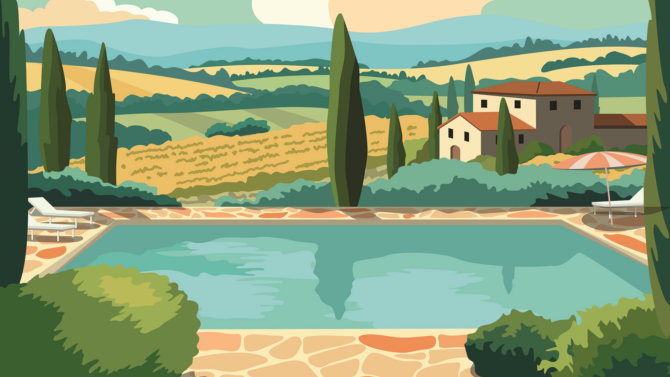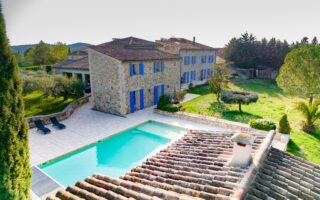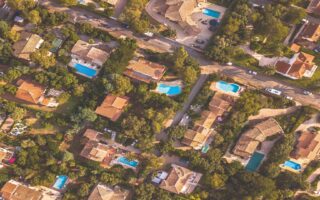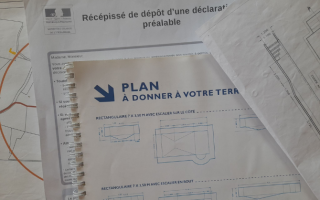How and where to build your new swimming pool in France

How and where to build your new swimming pool, with Julia French…
I can’t decide where to site our new pool: next to the house or away from it?
When a pool is close to the house it tends to get used more and it is always there… ready and waiting for those impulse swims. If you have an existing terrace to your property you may consider to connect this to your new pool area, to make it one seamless outside entertaining space.
With a pool further away you are more likely to stay there longer and not get distracted by things you (perhaps) would rather not be doing in the house. If this is your preferred choice, I would advise a pool house of some description, no matter how small, to house a fridge for those much-needed refreshments. This option provides you with new space while making use of another part of your garden.
The level of the top of the pool wall the water surface level – is an important factor for both scenarios. If the dig is not to the correct depth this could result in the pool being higher than your existing terrace, instead of being flush. This is not only unsightly but involves unnecessary work constructing steps in your patio. And if the pool is in view down your garden, you don’t want it poking up. The surrounding ground should be flat, not backfilled and banked up to the pool. You wouldn’t see a pond raised out of the ground!
There are also practical issues to consider, like access for the delivery of materials and, of course, the digger. In addition, you may have restrictions with regard to the declaration being approved. In some instances the pool has to be within 25 metres of the property. The pool always has to be at least three metres from the boundary or four metres if that is a road.
What size pool should I choose?
As a general rule of thumb, a house sleeping up to eight requires a pool of 8x4m; up to 12 a 10x5m; and up to 20 a 12x6m. However I have installed much smaller pools for much larger properties, and vice versa. It is a question of budget, space, aesthetics and who will be using the pool. In addition to the relative price involved with the increase in pool size, the same goes for the size of pool terrace. This is a commonly overlooked expense; the terrace design needs to be carefully considered to make sure the project doesn’t overspend, especially given the cost of concrete at the moment. Depending on the setting, instead of having an equal amount of terrace to each side, you could have im to three sides and 2.5m/3m to the other side giving plenty of room for the loungers. This works particularly well if you have a beautiful vista to overlook as it will not be blighted by a line of loungers on the opposite side.
Which filtration system is best: a cartridge/sac or a sand filter?
The cartridge filter is housed in a bloc de filtration at the poolside and the sand filter is housed in the pump room, which involves pipework to and from the pool, and equates to a more costly installation. However, in terms of performance the sand filter has more capacity to hold the dirt and debris than the cartridge option. To clean the cartridge filter you lift the cartridge out and hose it down; this can be heavy but it is simple.
The downside is that they can quickly get clogged up with the grease from lotions. If the cartridge isn’t cleaned or replaced in time this leads to poor circulation, thereby distributing a lower dose of chlorine to the pool, and if left too long, the pump can run dry.
The sand filter is less hands-on and is cleaned by switching the setting from filtration to backwash. This setting cleans the sand and all the dirt is flushed out to waste, not back to the pool. This takes up to two minutes and after a 20-second rinse programme, the sand is all clean and the system can be switched back to the filtration setting. To get the optimum filtration, your sand filter should be filled with glass media as this is more compact than sand. Not only that but also the glass only needs replacing every eight to 10 years, compared to every four with sand, and backwashing is only necessary every couple of months unlike the weekly ritual with sand.
Julia French is the founder of Pristine Piscines, a company which has been installing and renovating swimming pools in France since 2005.
Looking for more like this?
French Property News is the go-to title for anyone considering a French property purchase, either now or in the future. Packed full of expert advice from property professionals including estate agents, lawyers and tax advisors, it is the ultimate househunter’s guide to the French property market.
Lead photo credit : Photo: Shutterstock
Share to: Facebook Twitter LinkedIn Email
More in piscine, Pool, swimming pool
By Julia French
Leave a reply
Your email address will not be published. Required fields are marked *




